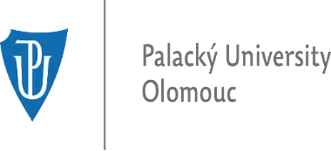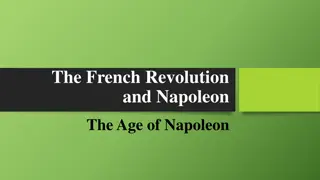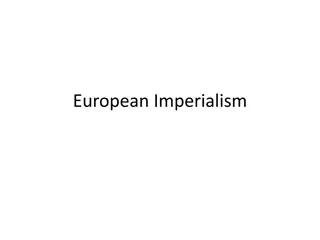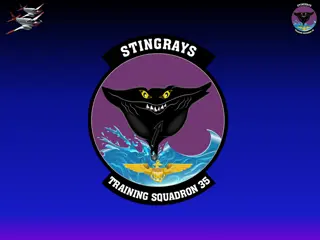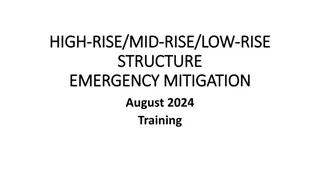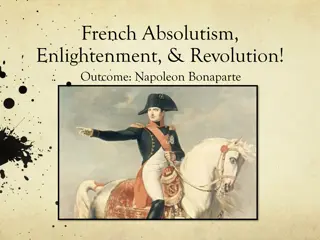European Identity Formation: Napoleon's Campaigns and Rise to Power
The history of Europe forming a European identity is exemplified through Napoleon Bonaparte's strategic campaigns in Northern Italy and Egypt. His victories against the Habsburgs strengthened his position, leading to acclaim upon his return to Paris. However, setbacks in Egypt and conflicts with Britain shaped his path to becoming First Consul of France. Napoleon's ambition and military prowess played a significant role in shaping Europe's identity during this transformative period.
Download Presentation

Please find below an Image/Link to download the presentation.
The content on the website is provided AS IS for your information and personal use only. It may not be sold, licensed, or shared on other websites without obtaining consent from the author. Download presentation by click this link. If you encounter any issues during the download, it is possible that the publisher has removed the file from their server.
E N D
Presentation Transcript
History of Europe forming a European identity 4
War in Northern Italy and the Rise of Napoleon Bonaparte Napoleon Bonaparte led the fight against the Habsburg-led Second Coalition against France in Northern Italy
War in Northern Italy and the Rise of Napoleon Bonaparte In this war, Napoleon demonstrated his strategic skills and thinking he gained wide- spread respect, especially from soldiers Battle of Lodi: 10 May 1796 and defeat of the Austrian Imperial Army This was followed by the Battle of Rivoli (14 January 1797), in which Napoleon again defeated the Austrian troops (while significantly outnumbered) As a result of the defeats on the Italian battlefields, the Habsburg Emperor Francis I asked for an armistice, which was confirmed by the Treaty of Campo Formio, signed in October 1797 The victorious campaign in Northern Italy strengthened Napoleon's position and he was lauded as a hero upon his return to Paris
Invasion of Egypt and Napoleon as First Consul In 1798, a conflict broke out between France and the United Kingdom Instead of the originally intended invasion of Britain, Napoleon supported the proposal of Foreign Minister Charles Maurice de Talleyrand to focus instead on limiting the influence of Britain in the Orient In 1798, therefore, Napoleon Bonaparte led the army that carried out a successful invasion of Egypt However, the French naval forces were defeated at the Battle of the Nile (1-2 August 1798) by the British fleet led by Admiral Nelson Napoleon was therefore forced to give up on the Egyptian campaign The only partly successful Egyptian campaign, along with failures of France on European battlefields led to a coup d' tat: in November 1799, the Directorium was replaced by the rule of the Three Consuls, among which Napoleon held the leading role as First Consul Mgr. Pavel Kr kora, Ph.D., Faculty of Education, Department of Social Sciences
France's War with the UK and the Third Coalition The conflict with the UK was reignited in 1803 invasion of French troops into Hanover Napoleon Bonaparte again plans an invasion of Britain In 1804 (2 December), Napoleon Bonaparte was crowned Emperor of France this act initiated the formation of the Third Coalition (UK, Austria, Russia and Sweden) The French naval forces were defeated at the Battle of Trafalgar (southwest of the port of C diz on 21 October 1805) by the British fleet led by Admiral Nelson The situation in continental Europe developed differently: Napoleon carried out an offensive in Southern Germany, defeated Austrian troops at the Battle of Ulm and clashed with the Russian troops of General Kutuzov at Hollabrunn, which retreated to Olomouc where they joined forces under Tsar Alexander I Mgr. Pavel Kr kora, Ph.D., Faculty of Education, Department of Social Sciences
The Battle of Austerlitz and the End of the Third Coalition In November 1805, Napoleon Bonaparte's troops advanced on Moravia The Russian Tsar Alexander I and the Austrian Emperor Francis I met in Olomouc and, against the consel of many generals, decided to battle the French troops. The decisive battle took place 2 December 1805 near the Moravian Austerlitz (Slavkov), in which Napoleon defeated the superior numbers of the combined Austro-Russian forces. This was Napoleon's most significant victory during the Napoleonic Wars, which de facto negated Britain's victory in the Battle of Trafalgar. The end result of the Battle of Austerlitz was the Peace of Pressburg on 26 December 1805, on the basis of which the territorially deprived Austrian monarchy became an ally of Napoleonic France. At the same time, the Holy Roman Empire definitively ceased to exist after the establishment of the French-controlled Confederation of the Rhine on the territory of the German lands. Mgr. Pavel Kr kora, Ph.D., Faculty of Education, Department of Social Sciences
The War of the Fourth Coalition The establishment of the Confederation of the Rhine caused the displeasure of Prussia, which retaliated against France in 1806, starting the war of the so-called Fourth Coalition (Prussia, Russia and the UK). The Prussian army, which had a reputation of "invincibility", suffered a series of crushing defeats in the conflict the most significant of which was the Battle of Jena on 14 October 1806. In November 1806, French troops occupied Berlin the capital of the Kingdom of Prussia. There Napoleon also declared a continental blockade of Britain. Napoleon Bonaparte then clashed with Russian troops in several indecisive battles (such as the Battle of Eylau). The turning point came with the Battle of Friedland (February 1807) in East Prussia, in which Russian troops were defeated. Subsequently, the Treaty of Tilsit was concluded, on the basis of which France and Russia became (temporary) allies. The Treaty of Tilsit also enabled the establishment of the Duchy of Warsaw.
War on the Iberian Peninsula In 1808, Napoleon's brother Joseph Bonaparte was installed on the Spanish throne This act provoked an uprising in Spain, which the French army tried to suppress During 1808-1814, there was a bloody guerrilla war between the Spanish rebels and France The UK also intervened in the war, invading Portugal under the command of Arthur Wellesley (Duke of Wellington) as a way of supporting the Spanish rebels. The French army never managed to fully defeat the Spanish insurgents and, in the end, the French had to withdraw in 1814, following Napoleon's unsuccessful campaign in Russia, and Joseph Bonaparte left Spain in 1813
The War of the Fifth Coalition In 1809, Austria opposed its "ally" of France, weakened by the conflict with Russia and the ongoing conflict in Spain. Napoleon Bonaparte's army entered the territory of Germany (Bavaria) and defeated the Austrian troops in several skirmishes In May 1809, Napoleon Bonaparte took Vienna without a fight and fought with Austrian troops in the Battle of Aspern-Essling, which ended in his defeat, but the French then had a decisive victory in the Battle of Wagram (July 1809). On 12 July 1809, the Austrian Emperor Francis I requested an armistice in Znojmo, which was sealed by a peace treaty concluded on 14 October 1809 in Sch nbrunn. The Austrian monarchy lost additional territory and the daughter of Francis I, Marie Louise was made to marry Napoleon Bonaparte
Napoleon's Russian Campaign At the end of 1810, Russia effectively refused to abide by the continental blockade of Britain and by this act terminated the existing alliance treaty with France. Napoleon Bonaparte finally responded in June 1812 with an invasion of Russia his army numbered about 600,000 men and was termed the Grand Arm e The Russian army, under the command of General Barclay de Tolly, retreated east to Smolensk, where in August 1812 there was a battle with an indecisive result General Kutuzov capable and experienced strategist took command of the Russian army, and in September 1812, one of the greatest battles of the Napoleonic Wars took place the Battle of Borodino near Moscow. The result of the battle was again indecisive, but with heavy casualties on both the French and Russian sides Napoleon then entered Moscow, which had been evacuated and set ablaze before his arrival During the autumn and winter, the French army fought several skirmishes with the Russians and was eventually forced to withdraw from Russia The Grand Arm e essentially broke up and the Russian campaign marked the first great defeat of Napoleon Bonaparte
The War of the Sixth Coalition As a result of the unsuccessful Russian campaign, France's allies, especially Austria, fell away. In January 1813, the Sixth Coalition was formed (Russia, Prussia, UK, Sweden and Austria). In March 1813, Prussia (joined by Austria) declared war on France victories occurred on both sides Over 16-19 October 1813 the Battle of Leipzig the largest battle of the Napoleonic Wars (also known as the "Battle of the Nations") took place. In this battle, Napoleon suffered a crushing defeat from the united forces of Prussian, Austrian and Russian troops and was forced to retreat to France Numerous skirmishes occurred during the French retreat, however, in late March, the troops of the Sixth Coalition arrived to Paris, causing it to surrender After pressure from his generals, Napoleon Bonaparte was forced to abdicate at Chateau de Fontainebleau and was exiled to the isle of Elba, accompanied by a thousand guardsmen France went back to being a monarchy and the French throne was taken by Louis XVIII from the House of Bourbon
Congress of Vienna After the defeat of France and the abdication of Napoleon, a congress was convened in Vienna by the victorious powers It is known to history as the Congress of Vienna. It established a new geopolitical map of Europe, which (with some changes) de facto lasted until 1918. Towards the end of the Congress, there was the Battle of Waterloo final defeat of Napoleon Bonaparte.
Congress of Vienna The Congress was attended by representatives of all the victorious powers and the defeated France one of the most important figures was the Austrian Chancellor Klemens W. von Metternich, effectively the main organiser of the Congress, the Russian Tsar Alexander I, Austrian Emperor Francis I, French Foreign Minister C. M. de Talleyrand and Arthur Wellesley, Duke of Wellington The Congress of Vienna ran from September 1814 to June 1815, often referred to as the "Dancing Congress" (frequent balls and banquets) The result was the organisation of Europe after the Napoleonic Wars stronger positions of power of Austria, Russia, Prussia and Britain. Monarchy was restored in France (House of Bourbon), merging of the Netherlands and today's Belgium; Austria had the decisive position in relation to the German Confederation (to the displeasure of Prussia) Establishment of the Holy Alliance Austria, Russia, Prussia; oversight over the organisation of Europe after the Congress of Vienna and policy of commitment to suppress revolutionary uprisings throughout Europe that could lead to the destabilisation of the state
The Revolution of 1848 and Its Causes The transformation of Europe after the Napoleonic Wars increased awareness of civil liberties, fundamental human rights and the right to self-determination which resulted in the rise of the phenomenon of national consciousness (Germany, Italy, Poland, Ireland and others) The Industrial Revolution, its acceleration in the first half of the 19th century and closely related changes in the social structure of contemporary society Expanded access to education Increased access to print and thus a better-informed larger segment of society in most European countries Revolutions in France (overthrow of the Bourbons and the establishment of a more liberally- oriented reign of Louis Philippe I) and Belgium in 1830, and partly also the Decemberist Revolt in Russia in 1825
Begginings of the 1848 Revolution Revolutionary unrest first cropped up in Southern Italy (Sicily, Naples) and was closely tied to Italian Risorgimento the movement to unify Italy January 1848, uprising in Palermo part of Kingdom of the Two Sicilies. In response to the uprising, King Ferdinand II promised a constitution The revolution rapidly spread to other parts of Italy, by February 1848 it was in Tuscany, which belonged to the Austrian monarchy
Begginings of the 1848 Revolution Leopold II, Grand Duke of Tuscany, also reacted to revolutionary events by putting out a constitution, however, there was also the demand for the separation of Tuscany and Veneto from the Habsburg monarchy and, in the north-east of Italy, an independent Venetian Republic was declared The Venetian Republic was supported by Sardinian King Charles Albert, who declared war on Austria in March 1848, which ended with the defeat of the Sardinian troops in the battles of Custoza (July 1848) and Novara (March 1849). At the head of the Austrian army was Marshal Radeck . These events are also referred to as the First Italian War of Independence
Revolution of 1848 in France The revolutionary events Italy quickly reverberated into France France was a constitutional monarchy headed by King Louis Philippe I (since 1830), who gradually deviated from liberal politics, causing widespread dissatisfaction Trigger for the revolution was the king's rejection of electoral reform in February 1848 Barricades were erected in Paris on 23 and 24 February 1848 and riots broke out Louis Philippe abdicated and took refuge in Britain France was declared a republic (Second French Republic) and the government, comprised of representatives of the bourgeoisie and the working class, started enacting numerous social reforms, including general suffrage, freedom of the press, abolishing capital punishment and slavery in the colonies
Revolution of 1848 in France Soon, however, disputes arose between the right and the left wings of the government, and after the shuttering of national workshops for unemployed workers, another uprising broke out in Paris in June 1848, which was eventually bloodily suppressed At the beginning of November 1848, the French parliament adopted a new liberal constitution and Louis Napoleon Napoleon Bonaparte's nephew was elected president. Louis Napoleon later granted himself dictatorial powers and, in 1852, declared himself Emperor Napoleon III
Revolutionary Events of 1848 in Germany In 1848, the territory of present-day Germany was a fragmentary collection of states of various sizes, many of which had been united since 1815 in the German Confederation (effectively replaced the former Holy Roman Empire). Prussia, led by its king, occupied a dominant position among the German states. Revolutionary events spread to Germany from France and Belgium the first of a series of revolutions took place in March 1848 in Baden, from where it spread farther throughout Germany the revolution of 1848 referred to in German history as M rzrevolution In many German states, liberal constitutions were passed along with numerous social reforms A core aspect of the revolution similarly to Italy was an effort to establish a unified German state (concept of "pangermanism") For this purpose, the All-German (Frankfurt) Parliament was convened in Frankfurt am Main in May on the basis of earlier elections. The Frankfurt Parliament deliberated on the adoption of a liberal imperial constitution the so-called unification of Germany "from bottom up" but did not gain the support of Prussia in this regard, which sought a "controlled" unification of Germany "from top down" .
Revolutionary Events of 1848 in Germany In 1849, the Frankfurt Parliament gradually broke apart when it was first abandoned by deputies from the Austrian lands and Prussia, then transferred its proceedings to Stuttgart, where it was dissolved with assistance from the military in June 1849. This event symbolically ended the German Revolution.
1848 Revolution in the Habsburg Monarchy Austria was an absolutist monarchy until 1848 under the mentally disabled Emperor Ferdinand I, the State Council, led by K. W. von Metternich, promoted a conservative policy following the conclusions of the Congress of Vienna in 1815 The revolutionary events made their way to Vienna from Germany in March 1848. The state council resigned. Matternich emigrated. The emperor promised a constitution and, soon, the first constitution in the history of the monarchy was presented (April 1848) called the Pillersdorf Constitution after its author On the basis of this constitution, a parliament (Imperial Council) was established and numerous liberal and social reforms were implemented (e.g., abolition of servitude, establishment of self-government and others) A major complication was the national issue the Habsburg monarchy contained many national entities within its borders, which at the time started strongly undergoing a process of developing a national consciousness
1848 Revolution in the Habsburg Monarchy Within the various parts of the monarchy, therefore, the revolution had a strong national subtext especially in Hungary, Northern Italy and the Czech lands As a result of the unrest from people seeking national autonomy in Hungary, a second revolutionary wave broke out in Vienna in October 1848. The parliament transferred its proceedings to Krom in Moravia, and the emperor and court took refuge in Olomouc, Moravia, where Ferdinand I abdicated and on 2 December 1848, the young Franz Joseph I ascended the Austrian throne.
1848 Revolution in the Habsburg Monarchy The situation in the Habsburg monarchy gradually stabilised over the spring of 1849. In March, the parliament was dissolved and the government put out the Imposed Stadion Constitution with the emperor's approval. This act symbolically ended the revolutionary period. However, as a result of the revolutionary years 1848/1849, the Habsburg monarchy was transformed into a constitutional monarchy, in which parliamentary life and the foundations of civil society developed over the following decades.
1848 in Other European Countries The revolutionary wave of 1848 also affected Belgium, to a lesser extent unrest appeared two years prior February and March 1846 in Krakow, where insurgents opposed Austrian rule The revolutions of 1848 basically missed the UK at this time, the country with the most developed industry and transport infrastructure, the world's foremost naval power and a country with a stable parliamentary system The revolutionary year of 1848 was quite intense in Hungary, which was part of the Habsburg monarchy. Hungary essentially demanded independence. As early as March 1848, establishment of an independent Hungarian government, headed by Lajos Batthy ny, and in early 1849, an independent "Hungarian" republic was declared, headed by Lajos Kossuth The unrest in Hungary related to the revolution of 1848 was definitively suppressed only with the help of Russian troops in August 1849, when the "rebels" were defeated in the Battle of Vil gos. The revolution of 1848 also did not affect the Russian Empire in any way, with the patriarchal tsarist regime maintain a strong grip







